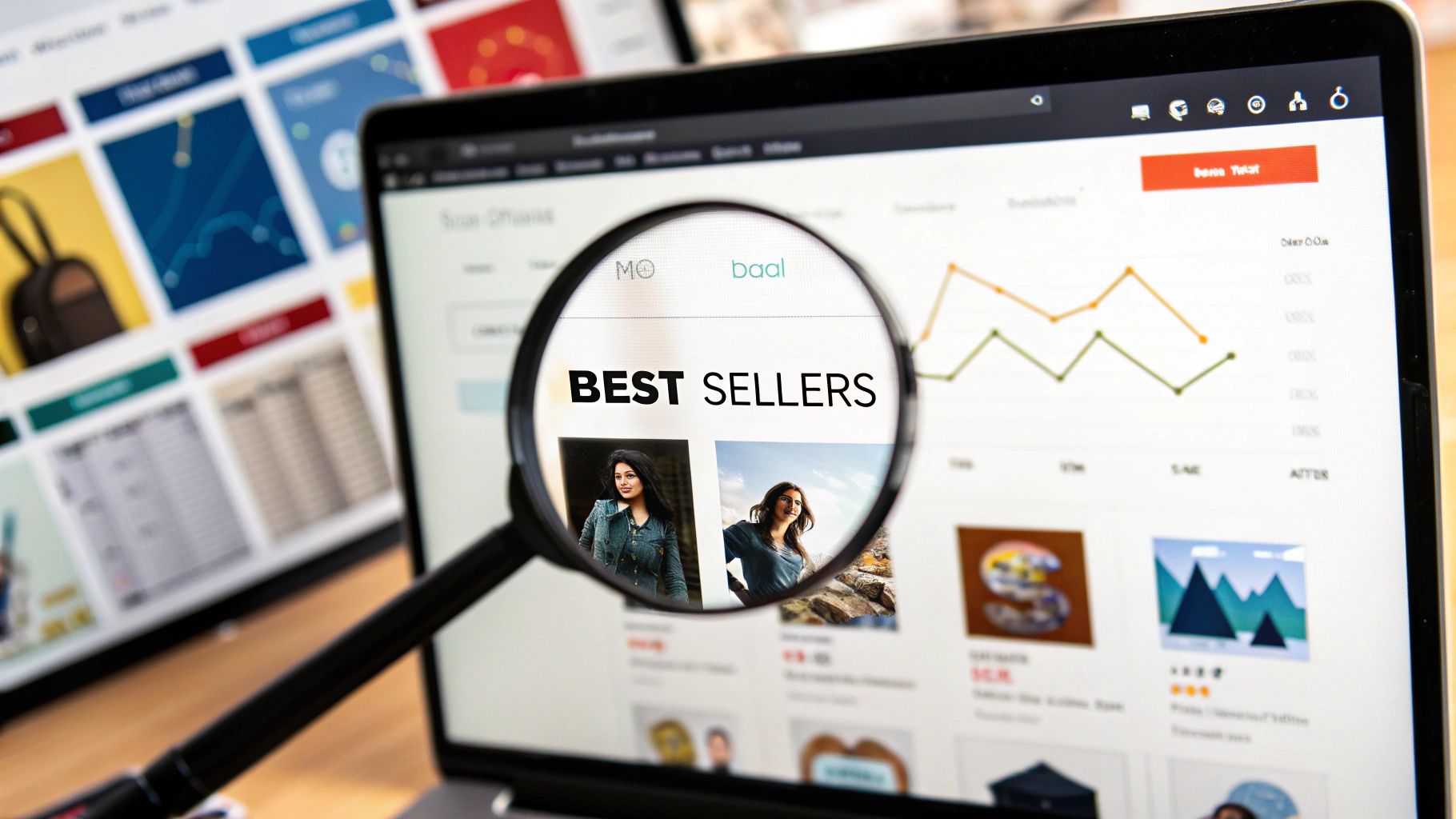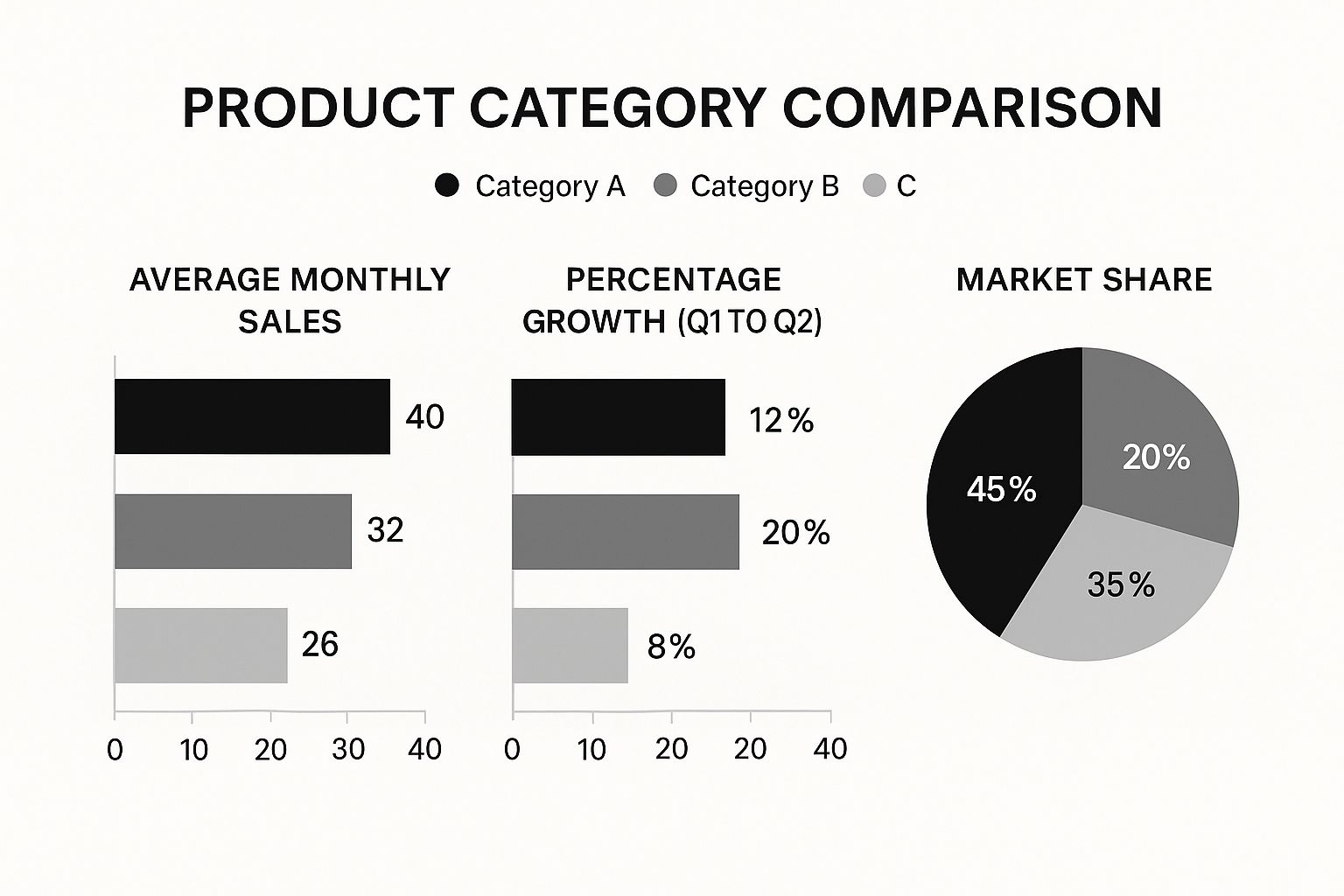
Let's be honest, finding a "winning" product to sell online can feel like trying to catch lightning in a bottle. It’s easy to get overwhelmed by the sheer number of options or fall for a trendy item that fizzles out as quickly as it appeared.
But here’s the secret the pros know: it's not about luck or guesswork. It's about having a system. The most successful sellers don't just stumble upon great products; they follow a repeatable, data-backed process to find, analyze, and validate them before a single dollar is spent on inventory.
Your Blueprint for Finding Winning Products
Think of this guide as your blueprint. We’re not just going to point you to a list of "hot" products. Instead, we're going to teach you a market-first approach that flips the script. You'll learn how to build your business on a solid foundation of research, not just a gut feeling about a cool-looking gadget.
The goal here is to trade in the guesswork for a clear, actionable framework. We'll move beyond chasing fleeting fads and show you how to spot genuine, sustainable consumer demand. This means getting comfortable with market data, using some seriously powerful tools to spot trends, and learning how to put every potential product through a reality check.
Adopting a Strategic Mindset
This strategic mindset is what separates the stores that thrive from the ones that quietly disappear after a few months. It’s all about asking the tough questions before you even start looking for suppliers.
- Is there real demand? We'll dive into how you can tell the difference between a one-hit-wonder and a product people are consistently searching for.
- What's the competition like? A massively popular product might seem like a sure thing, but if you're up against thousands of other sellers, it's a tough fight. Sometimes, a niche product with a hungry, underserved audience is the smarter play.
- Can you actually make money? Profit margins are everything. We'll walk through how to calculate all your potential costs—from the product itself to shipping and marketing—to see if the numbers truly add up.
Shifting your focus to data-driven discovery first gives you a massive advantage. You can confidently pick products you know have potential, which dramatically cuts your risk and sets you up for long-term success.
Getting a Feel for the Modern eCommerce World

Before you even start hunting for the best selling products online, you need to get the lay of the land. Think of the eCommerce space not as a single store, but as a massive, constantly shifting city. New neighborhoods—your product niches—spring up all the time, while platforms like Amazon and social media act as the superhighways connecting millions of shoppers to products in the blink of an eye.
This city isn't just getting bigger; it's getting smarter and more connected. The way people discover, research, and buy products is always changing. If you can get a handle on these big-picture trends, you can position your business to ride a huge market wave instead of just chasing small, fleeting fads. This is the stuff that separates a flash-in-the-pan seller from a truly resilient, long-term business.
The Big Shifts Driving Online Sales
The numbers behind this growth are almost hard to believe. Global eCommerce sales are on track to hit a staggering $7.5 trillion by 2025, which is a huge jump from $5.7 trillion in 2023. This is happening because nearly 85% of consumers around the world now shop online. By 2025, it’s expected that 24% of all retail sales will happen on the web. You can dig into more of these numbers by checking out recent digital commerce statistics.
So, what's behind this massive shift? It really boils down to a few key changes in how we shop:
- Mobile is King: Most online shopping doesn't happen on a laptop anymore. It happens on a phone. That means your product pages, ads, and checkout process have to look perfect and work flawlessly on a small screen.
- AI Runs the Show: Ever wonder why you see certain product recommendations? That's AI. Algorithms are personalizing the shopping experience for everyone, guiding customers to products they’re more likely to buy.
- Social Media is the New Mall: Platforms like TikTok and Instagram are no longer just for scrolling. They've become full-blown marketplaces where you can watch a video and buy the product right there, without ever leaving the app. This is social commerce, and it's a game-changer.
Think of these forces as a map of that digital city. It shows you where the traffic is heaviest and where the most valuable real estate—customer attention—is concentrated.
When you truly grasp these fundamental shifts, you start seeing real opportunities everywhere. You can predict where customer behavior is headed and pick products that fit naturally into these powerful, long-term currents. It’s how you build a business on solid ground, ready for whatever comes next.
How to Spot High-Demand Product Categories

Before you can pinpoint a single winning product, you first need to know where the money is flowing. Think of the online marketplace like a massive city. Some districts are always packed and buzzing with activity, while others are sleepy and quiet. Your first job is to find those bustling commercial hubs—the product categories where people are already spending their money, day in and day out.
Starting with these broad categories gives you a huge strategic advantage. It’s no secret that some sectors are perennial powerhouses. For instance, by 2025, consumer electronics are expected to dominate online sales, pulling in an incredible $922.5 billion. Fashion and apparel aren't far behind, with a projected $760 billion. This tells us that the demand for gadgets and new clothes isn’t going anywhere.
So, what does this mean for you? While you probably aren’t planning to take on Apple or Nike directly, this data points you toward fertile ground. Instead of trying to sell smartphones, you could carve out a niche selling high-demand accessories like premium phone cases or innovative wireless chargers.
Breaking Down Billion-Dollar Markets
The real opportunities appear when you start breaking these massive categories into smaller, more manageable niches. A great, straightforward way to do this is by regularly checking out current best-selling product lists on major marketplaces. These lists give you a real-time pulse on what customers are actually buying, moving you from theory to tangible proof.
As you dig into these categories, keep an eye out for patterns that signal a smart opportunity:
- Evergreen Essentials: These are the products people buy over and over, all year round. Think pet supplies like cat litter or health staples like protein powder. The demand is steady and predictable, even if the competition is strong.
- Hobbyist Hubs: Look for categories that cater to passionate communities, like Arts & Crafts or Sports & Outdoors. People invested in a hobby are often willing to pay a premium for specialized gear, whether it's high-quality yarn for knitting or insulated ice packs for camping coolers.
- Problem-Solvers: Many of the best-selling items don't just look good; they solve a common, nagging problem. Under-cabinet lighting brightens up dark kitchen counters, and acne patches offer a quick, discreet fix for breakouts.
Think of a massive category like "Home & Kitchen" as an entire continent. Your goal isn't to conquer the whole thing. Instead, you're looking for a small, prosperous country within it—a niche like "insulated tumblers" or "countertop icemakers"—where you can establish a strong presence.
Below is a quick overview of some of the largest online markets, giving you a clearer picture of where consumer dollars are being spent.
Top Performing Online Product Categories
This table summarizes the leading product categories by their projected global online sales, showing where consumer spending is highest.
| Product Category | Projected Global Sales | Key Consumer Drivers |
|---|---|---|
| Electronics & Media | $922.5 Billion | Constant innovation, remote work, entertainment |
| Fashion & Apparel | $760 Billion | Trend cycles, influencer marketing, self-expression |
| Furniture & Appliances | $450 Billion | Home improvement trends, new homeowners, nesting |
| Toys, Hobby & DIY | $410 Billion | Passion-driven purchases, family activities, DIY culture |
| Food & Personal Care | $340 Billion | Health & wellness trends, convenience, subscription models |
These figures highlight the sheer scale of opportunity within established markets. Each one contains countless sub-niches ripe for exploration.
The Influence of Social Commerce
One of the biggest forces shaping what sells today is social commerce. Platforms like TikTok and Instagram have evolved from places of discovery into powerful sales channels. In fact, global social commerce is on track to generate a staggering $1.2 trillion by 2025.
This trend means a niche product can be catapulted into a best-seller almost overnight thanks to a viral video. Learning https://letsparty-au.myshopify.com/blogs/news/how-to-find-trending-products by keeping a close eye on these platforms is no longer optional—it's essential. Pay attention to what creators are showcasing and what their audiences are buzzing about. You might just spot the next big thing before it becomes mainstream.
Using Data Tools for Smarter Product Research
Trying to find the best selling products online based on a gut feeling is a bit like navigating a new city without a map. Sure, you might stumble upon your destination eventually, but you'll likely waste a ton of time and energy on dead ends. The pros don't guess; they use data tools as their GPS, guiding them straight to high-demand products with clear, undeniable evidence.
These tools fundamentally change how you approach product research. Instead of asking, "What do I think people will buy?" you can ask, "What is the data showing me people are actively searching for and buying right now?" It's a simple shift, but it’s the key to minimizing risk and building a business on a solid foundation of real consumer demand.
Visualizing Demand with Google Trends
One of the best and most accessible tools out there is Google Trends. Think of it as a historical chart of a product's popularity, letting you visualize public interest over time. It reveals crucial patterns that are otherwise invisible.
A quick search can help you instantly spot:
- Seasonality: You'll see predictable spikes for "portable fans" every summer or "heated blankets" every winter. This is gold for timing your marketing.
- Rising Stars: Is a term like "walking pad" showing slow, steady growth? That's a great sign of an emerging, long-term trend.
- Fading Fads: Remember "fidget spinners"? Google Trends shows its massive, short-lived spike followed by a spectacular crash. This helps you avoid jumping on a bandwagon that has already left town.
For example, this simple search shows the cyclical interest in "ice packs," with obvious peaks every single summer.
Understanding these cycles helps you time your product launches and ad campaigns perfectly to catch the wave of consumer interest.
Measuring Search Intent with Keyword Tools
While Google Trends shows what's popular, keyword research tools like Ahrefs or Semrush measure intent. They tell you exactly how many people are looking for a specific product each month and the exact words they use. It’s like listening in on millions of customer conversations.
For instance, a high search volume for "best noise-cancelling headphones for studying" points to a specific audience that knows their problem and is ready to buy a solution. You can dig into metrics like search volume, keyword difficulty, and cost-per-click to size up both the market opportunity and the competition. If you want to go deeper on this, there are several top trend analysis methods to reveal data insights.
Spying on Success with Amazon Best Sellers
At the end of the day, nothing beats hard sales data. Amazon's Best Sellers lists are a treasure trove, showing you exactly what’s flying off the digital shelves right now. This isn’t a guess about demand; it’s a live look at what customers are actually buying.
By triangulating data—visualizing interest with Google Trends, measuring intent with keyword tools, and confirming sales with Amazon's lists—you build an undeniable, evidence-based case for your product choices.
To really make this data work for you, especially in your marketing, it helps to understand how tracking pixels function on your e-commerce site. Getting a complete picture of customer behavior often requires a proper setup. You can review insights into pixel implementation and migration for Google Analytics on Shopify to see a real-world example of how this works. This holistic approach ensures you aren’t just picking a product, but investing in a proven market.
Discovering Hidden Gems in Niche Markets
It’s always tempting to jump on the bandwagon and sell the products everyone is buzzing about. But the real money is often made where most people aren't even looking. Trying to compete in a massive market like consumer electronics means you're up against thousands of other sellers, all fighting for the slimmest of profit margins.
A much smarter approach is to find your own niche market. This is a smaller, more specialized corner of a bigger industry that caters to a passionate—and often overlooked—group of customers.
Think of it like fishing. You could join the crowd and cast your line into a huge, overfished lake, hoping for a lucky bite. Or, you could find a quiet little cove where a specific type of fish is abundant and no one else is around. The second option takes a bit more research, but your odds of a great catch are dramatically better. In eCommerce, those coves are where you find the products that will actually build a profitable business.
Why Niche Markets Drive Real Profit
The logic behind targeting a niche is beautifully simple: it's where high demand meets low supply. When you find something that a specific group of people is desperate for but can't find anywhere else, you've hit the jackpot. This sweet spot gives you pricing power, much healthier profit margins, and a base of loyal customers who feel like you finally get them.
A fantastic, real-world example is premium cat litter. It doesn't sound exciting, but the numbers tell a different story. A quick look at major eCommerce platforms shows cat litter pulls in over 200,000 monthly searches on Amazon alone. Despite this huge demand, the competition is surprisingly low, with only about 500 listings.
With an average price tag of $36 and an annual revenue per listing that tops $226,000, it's an incredibly lucrative hidden gem. You can dig into more surprising eCommerce statistics and product insights on Bloggingwizard.com.
Tapping into a niche market isn’t about selling weird, obscure items. It's about selling everyday essentials, unique hobby supplies, or clever problem-solvers to a focused audience that big-box retailers tend to ignore.
How to Find Your Niche Opportunity
Uncovering these opportunities is like being a detective. Your main job is to investigate the relationship between what people are searching for and how many sellers are actually providing it. You're hunting for a gap in the market.
Here are a few product categories that are often goldmines for niche best-sellers:
- Hobbyist Supplies: Think of specialized equipment for knitting, backcountry camping, or tabletop wargaming. Hobbyists are incredibly passionate and are more than willing to pay a premium for high-quality gear.
- Problem-Solvers: Products that solve a very specific, nagging problem can become cult classics overnight. Items like motion-activated under-cabinet lighting or a perfectly engineered travel pillow fall right into this category.
- Passionate Communities: Find products that serve a community with a powerful shared identity. This could be anything from sustainable goods for eco-conscious consumers to specialized supplements for vegan athletes or unique accessories for owners of a specific dog breed.
By focusing your energy on these less-crowded spaces, you can completely sidestep the brutal price wars that plague mainstream markets. Instead of just moving boxes, you get to build a brand that connects with a dedicated audience, turning first-time buyers into lifelong fans and creating a business with a real competitive edge.
Validating Your Product Ideas Before Launch
You've got a shortlist of promising products. That’s a fantastic start, but now comes the hard part: how do you pick a real winner without just guessing? This is where validation comes in. It’s the critical step that separates sellers who build sustainable businesses from those who just throw things at the wall to see what sticks.
Think of it as switching gears from an emotional, "I think this is a cool product" mindset to a logical, "The data says this product can succeed" approach. This process is your final sanity check before a single dollar is spent on inventory. It's about minimizing risk and dramatically boosting your chances of launching one of the best selling products online.
Building Your Product Scorecard
To really put your ideas to the test, you need to evaluate them against a few core business metrics. You don’t need a complicated spreadsheet—just an honest look at each product's real-world potential.
Start by asking these tough questions:
- Can it actually make money? What’s the profit margin potential? After you factor in the cost of the product, shipping, marketing, and marketplace fees, is there enough left over to make it worthwhile?
- Is it a nightmare to ship? Think about shipping and logistics. Is the product big, heavy, or fragile? Complicated shipping can demolish your profits and lead to endless customer service headaches.
- Is anyone actually looking for it? What's the market size and demand? Go back to your data tools and confirm there's a hungry, sizable audience for what you want to sell. A cool product with no buyers is just a hobby.
- How crowded is the field? Assess the competition level. If a dozen sellers are already locked in a price war over a similar item, you’ll have to spend a fortune on ads just to get noticed.
This infographic gives you a bird's-eye view of how different product categories are performing right now, highlighting key data points like average sales and growth.

Looking at this data, you can start to see how a massive market might have slow growth, while a smaller niche could be exploding. It’s all about finding the right balance for your goals.
To make this process even clearer, use a simple scoring system to compare your top contenders side-by-side.
Product Viability Scorecard
This table helps you objectively rate each product idea against the crucial factors that determine success in e-commerce.
| Evaluation Criterion | What to Look For (High Score) | Red Flags (Low Score) |
|---|---|---|
| Profit Margin | Healthy margin (40%+) after all costs. | Thin margins (<20%) that leave no room for error. |
| Market Demand | Consistent, year-round search volume. | Niche is too small or highly seasonal. |
| Competition | A few competitors, but with clear weaknesses. | Saturated market with dominant, established brands. |
| Shipping & Logistics | Small, lightweight, and durable. | Large, heavy, fragile, or requires special handling. |
| Sourcing Difficulty | Multiple reliable suppliers available. | Single supplier or complex manufacturing process. |
| Marketing Potential | Obvious target audience; "shareable" product. | Difficult to market visually or explain its value. |
By running each of your ideas through this scorecard, you'll quickly see which one represents a calculated, manageable risk with a clear path to becoming a profitable venture.
The goal isn't to find a "perfect" product with no downsides. Every product has challenges. You're looking for the one with the best-balanced scorecard.
One last pro tip: dig into the customer reviews for competing products. What are people constantly complaining about? If you can source or create a version of the product that solves those specific problems, you've just handed yourself a massive competitive advantage. Just make sure you know how to spot fake reviews so you’re basing your decisions on what real customers are saying.
A Few Common Questions
How Can I Tell if a Product Is Truly in High Demand?
Spotting a product with real, untapped demand is a bit like being a detective. You have to look for clues across the digital landscape. A great place to start is with the big players, like Amazon; check out their Best Sellers or even the "Most Wished For" pages to see what people are actively buying and dreaming about right now.
But don't stop there. Look for the digital breadcrumbs. Use a tool like Google Trends to see if search interest is climbing over time. A steady upward trend or consistent buzz on social media, especially on visual platforms like TikTok and Instagram, is a huge green light that you're onto something good.
What Kinds of Products Always Seem to Sell Well on Amazon?
Some categories are just evergreen. Year after year, electronics, fashion, home & kitchen goods, and beauty & personal care items are absolute powerhouses on Amazon. Health and wellness products also tend to have a very stable, consistent sales record.
The catch? Trends within these categories can change in the blink of an eye. That's why even in these safe-bet markets, you have to stay on your toes and regularly research what's currently hot to find the real winners.
A killer strategy is to find a proven, high-demand category and then offer a unique product that solves a very specific problem within it. This way, you get the stability of a big market with the advantage of a niche offering.
Do I Have to Constantly Be Adding New Products to Succeed?
Not at all. In fact, that can be a recipe for burnout. While staying current is important, a more balanced and sustainable approach usually wins the day. Chasing every single new trend can get expensive fast, and it’s no guarantee of success.
A much smarter move is to build a solid foundation of a few popular, evergreen products that consistently sell. Then, you can strategically sprinkle in new, trending items from time to time. This keeps your store feeling fresh and exciting without forcing you to reinvent your entire business every few months.
Ready to stop guessing and start discovering products with proven demand? At FindTopTrends, we curate the latest high-quality, trending items so you can shop smarter and stay ahead of the curve. Explore our collections and find your next best-seller today!










